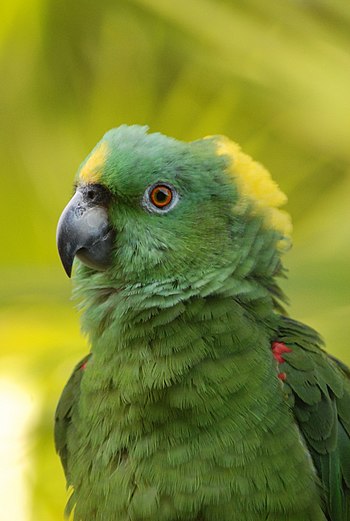 |
|
Yellow-naped Parrot or Yellow-naped Amazon (Amazona auropalliata)
at Gatorland. (Photo credit: Wikipedia) |
The Yellow-naped Parrot or Yellow-naped Amazon is considered to be a
sub-species of Yellow-crowned Amazon. It is notable by its green forehead and
crown and a yellow band across the lower nape of their neck. The reason this
parrot is well-liked as a pet is because they mimic sounds, and when in
captivity this includes humans and anything else that they hear plus they have
a mischievous personality. During the breeding season, males are known to bite
because they feel that they are defending their nest.
The Yellow-crowned Parrot averages about the same size as the Yellowhead
Amazon parrot their tail is more squares and have mostly all green feathers
and dark blue tips which are difficult to see when they are on a perch. The
amount of yellow on the parrot varies which is restricted to the crown-region,
hence the name. They are usually found in pairs or small flocks and as with
most parrots, their foods consist of fruits, nuts, and seeds and berries. They
like to nest in hollow trees and they lay anywhere from 2 -3 eggs and the
incubation time is only about 26 days about sixty days after hatching they
leave the nest.
Amazon parrots such as the Yellow-headed Amazon, Yellow-naped Amazon, and
Yellowface parrot (which is declining or has already disappeared in large
areas of its former range in Brazil, are all generally kept as pets because of
their extraordinary speaking abilities, mischievousness, and agility with
their feet. They can live up to fifty years old and make very devoted pets.
Nevertheless, even well-taught parrots can become hostile dunning mating
season.
These Amazon yellow parrots require more attention than our domesticated cats
or dogs. Which involve making sure these birds have plenty of chewing toys and
branches. They enjoy chewing wood and should be provided with chunks of pine
or fir wood. They also love branches with leaves which they benefit from the
nutrients obtained from chewing leaves and green bark. Good types of branches
to offer to include willow, honeysuckle, eucalyptus, palms, bottle brush, and
fruitwoods. These parrots can be destructive that is why they need
non-destroyable safe toys as well. They don't seem to have the nervous
plucking of their feathers as some species.
They are very active birds they prosper in an area that allows them to fly and
move around, an aviary is a large enclosure for confining birds and would be
recommended because unlike cages, aviaries permit the bird to have a larger
living space where they can fly. They need a proper diet which would consist
of fresh vegetables and fruits, sprouted seeds and grains, and other whole
foods that will keep your parrot healthy.
How yellow parrots or any parrot for that matter has been raised will
drastically affect its personality. Parrots vary in their temperament, noise
level, talking capability, attraction to people and care that they need. They
can be a joy to have in your life.
Among the Amazon parrots beside the Yellow-headed, Yellow-naped,
Yellow-crowned you will also find the Orange-winged Amazon, and Blue-fronted
Amazon, which is as well frequently kept as pets. All of these birds along
with Macaws and the African Greys are known for their outstanding vocal
abilities.
|

